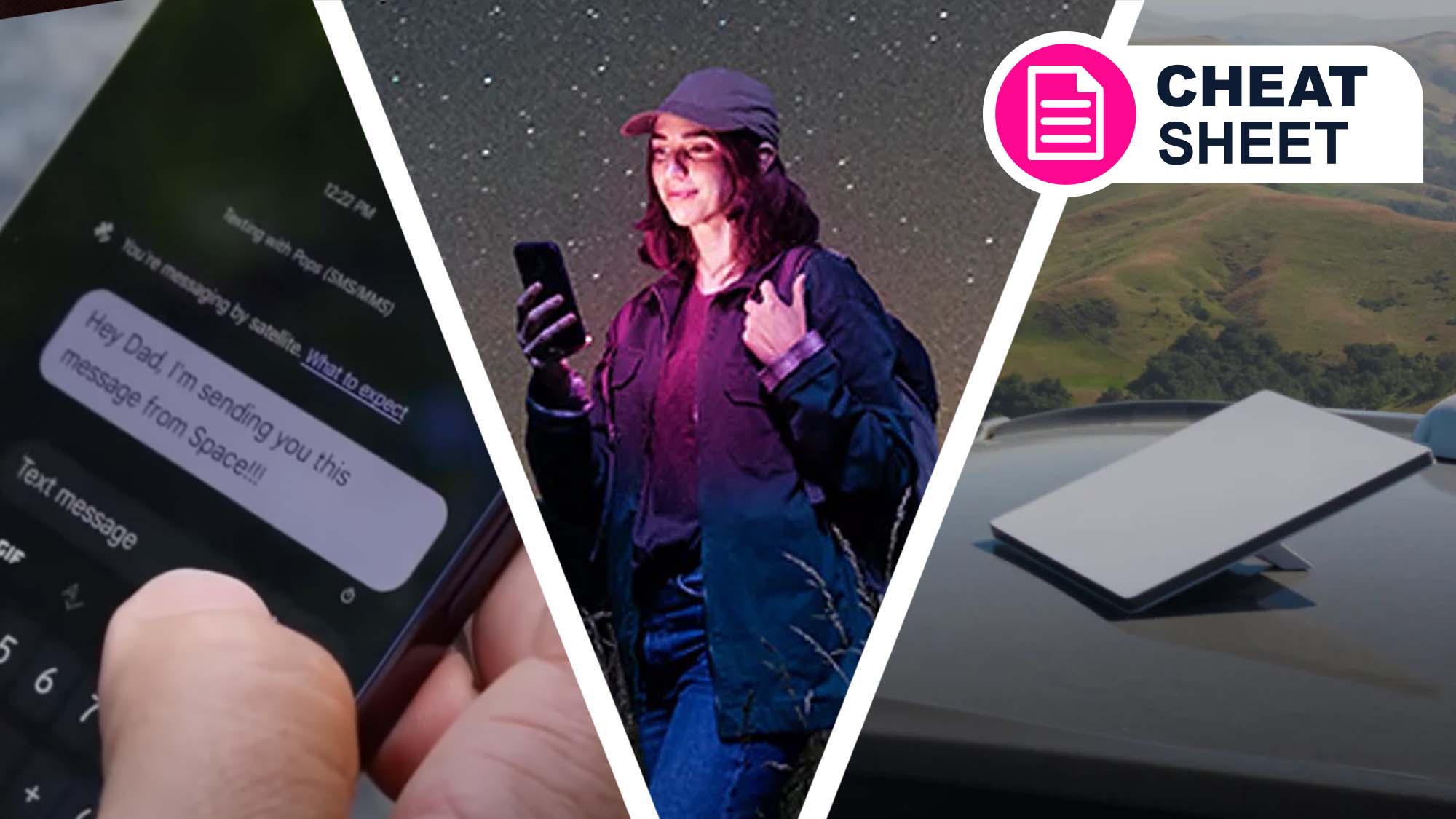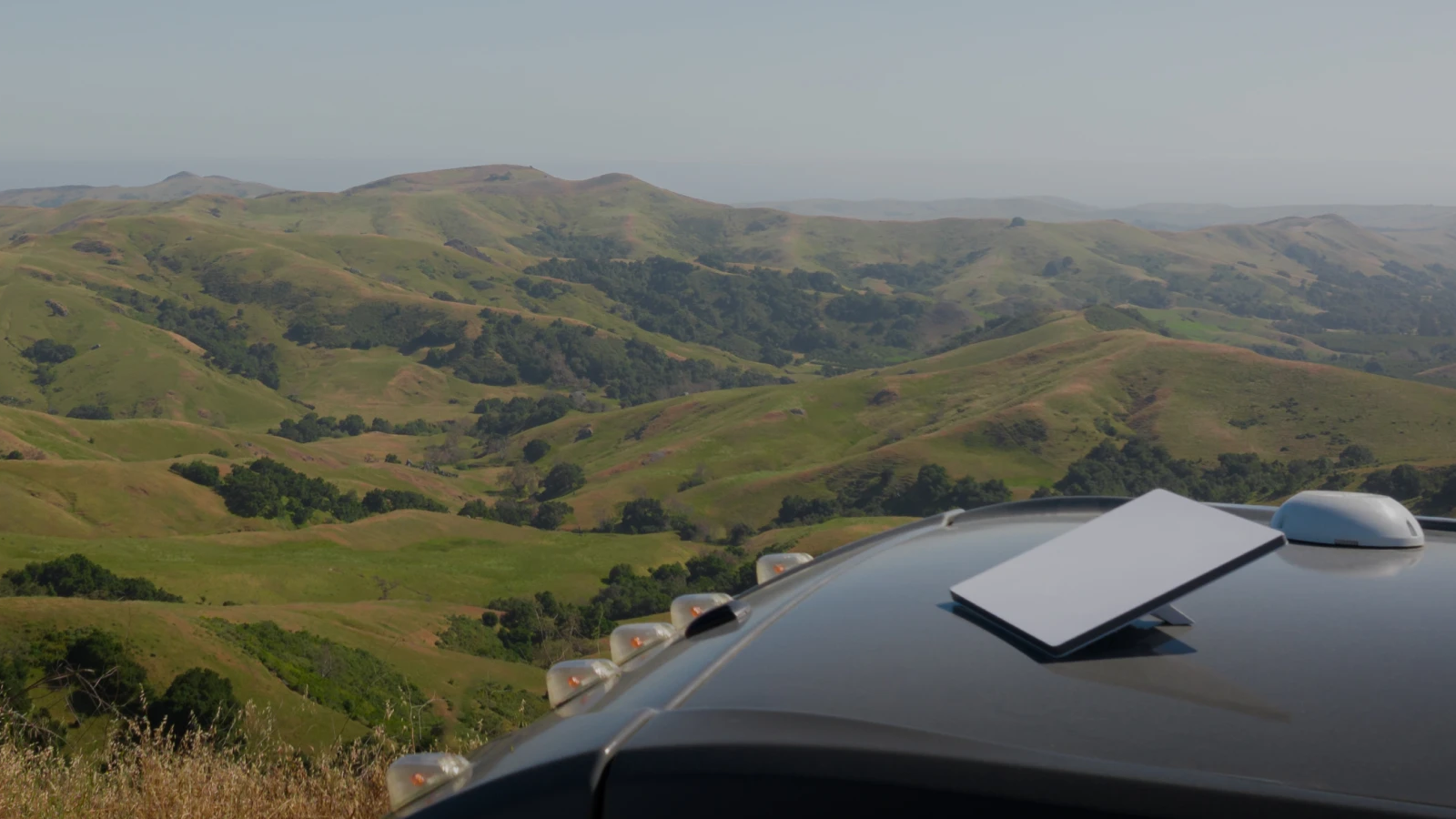What is Starlink? How to get the satellite service for free on your phone with T-Mobile, plus everything you need to know
Starlink is going mainstream – here's how to get it

There’s never a good time to find yourself with no mobile reception. Whether you want to look up directions on Google Maps, send someone a WhatsApp message, or just want to post a beautiful view on Instagram: zero bars on your smartphone won’t get you very far. That's where satellite services like Starlink come in, which T-Mobile is now offering for free (ahead of a paid rollout) in the US on compatible smartphones.
The network operator has teamed up with SpaceX to launch the “first and only space-based mobile network” in the US, bringing cell phone service to remote areas via satellite. Powered by Starlink, it’s set to change the game for mobile users in rural locations, which is also the stated aim of Amazon's imminent Project Kuiper. Those users won’t have to wait long to access it, either: the beta trial is already underway and a full rollout is scheduled for July this year.
What’s more, access isn’t limited to T-Mobile customers. The carrier has made its new service available to both AT&T and Verizon users as well, provided that their phone supports an eSIM. Want to upgrade your coverage with the groundbreaking satellite-to-cell service? We’ve broken down everything you need to know about T-Mobile Starlink, including how you can get it and how much it costs.
What is Starlink and how does it work?
- Starlink is a subsidiary of Elon Musk’s SpaceX
- It operates a constellation of small internet satellites
- Direct-to-cell satellites work like cell towers in space
Starlink is a subsidiary of SpaceX, the space exploration company owned by Elon Musk. Starlink owns and operates a constellation of thousands of small satellites. It has been launching these compact satellites into space since 2019. They are used primarily to serve high-speed internet to Starlink customers with a compatible antenna on the ground.
Unlike traditional satellite internet services, Starlink’s satellites circle the planet in a low-Earth orbit. This closer proximity to the Earth’s surface helps to reduce the lag – or latency – experienced as data is relayed between a user’s antenna and the orbiting satellite. Because of the high number of Starlink satellites, the system is also able to offer global coverage, reaching areas beyond the scope of standard broadband or fibre optic connectivity. This makes it a particularly useful service in rural locations.
Early last year, SpaceX started launching Starlink satellites equipped with direct-to-cell capabilities. These satellites have modems on-board which function the same as cellphone towers. No special antenna or other hardware is required to connect to them: they are seen by your smartphone as standard cell towers, albeit up in space.
This means active users can access Starlink coverage wherever they can see the sky. If a phone supports LTE, it can connect to Starlink’s satellite-based network the same as if it’s a normal terrestrial provider.
Get daily insight, inspiration and deals in your inbox
Sign up for breaking news, reviews, opinion, top tech deals, and more.
Starlink on phones: how does T-Mobile’s new mobile service work?
- T-Mobile’s Starlink service is powered by SpaceX satellites
- Free public beta testing launched in February
- Paid subscriptions available from July for T-Mobile, AT&T and Verizon users
T-Mobile’s new service is powered by Starlink satellites which are equipped for direct-to-cell connectivity. According to T-Mobile, 451 of these satellites have been launched so far. As above, these work like cell towers in space. Wherever you can see the sky, compatible smartphones can connect to T-Mobile Starlink as if it’s a normal mobile network. No additional hardware or antenna is needed.
That means whenever you’re in an area without cell service, your smartphone will connect automatically to Starlink satellites. T-Mobile reckons that more than 500,000 square miles of the US is currently beyond the reach of any carrier’s standard cell towers. Its new service should eliminate those mobile dead zones, allowing users to stay connected wherever they are in the US.
T-Mobile launched the free public beta test of its Starlink service during the Super Bowl on February 9 2025. It’s open for anyone on any US carrier to sign up, including customers of both Verizon and AT&T. Registered users will be given access on a rolling basis, to provide feedback before the full rollout in summer.
In July, T-Mobile Starlink will switch to a paid version. It will be included free for anyone on T-Mobile’s Go5G Next plan. Other T-Mobile customers can access it as a paid add-on for $15 a month. Anyone who registers for the beta in February will also be offered an Early Adopter Discount, bringing the price down to $10 a month.
Verizon and AT&T customers will also be able to continue using the T-Mobile Starlink service once it switches to a paid version, as will users of any wireless network with an unlocked eSIM phone. This will cost $20 a month and users will need to activate a second eSIM in their phone to access the network.
At launch, the service only supports text messaging when connected to the satellite network. T-Mobile states that voice and data will be added soon, although this will require government approval for SpaceX to use the full bandwidth capacity of its satellite constellation.
Starlink on iPhone: how do you get it?
- T-Mobile Starlink works on most modern smartphones
- Apple iPhone 14 models and later are supported
- iPhones need to be running iOS 18.3 to access Starlink
The only way to get Starlink on an iPhone at present is to sign up to the T-Mobile beta test. To do that, you’ll need to have an iPhone 14, iPhone 15 or iPhone 16. That includes the Plus, Pro & Pro Max variants. You’ll also need to be running iOS version 18.3.
Contrary to TikTok rumors, iOS 18.3 does not secretly install Starlink tech on your iPhone. What it does is make the network settings changes necessary to allow your phone to connect to T-Mobile 1900Mhz spectrum.
You’ll then need to register for the T-Mobile beta. Once you’re approved to participate and you head somewhere outside of standard cellular range, your phone should automatically access network coverage via the Starlink satellite constellation. When it does, you’ll see “SAT” instead of the standard bars in the top right corner of your iPhone.
It’s not just Apple iPhone users who can access the public beta. According to T-Mobile, Starlink “works on most smartphones from the last four years.” While no additional hardware or accessory is required to connect to the Starlink network, T-Mobile does state that smartphones need to be “satellite optimized” for users to have the best experience.
T-Mobile says it has worked with both Apple and Google to “ensure that this experience is integrated directly into their OS.” Whatever phone you have, T-Mobile states that it “needs to be on the latest software to use T-Mobile Starlink.”
The official list of supported handsets is as follows:
- Apple iPhone 14 and later (including Plus, Pro & Pro Max)
- Google Pixel 9 (including Pro, Pro Fold, & Pro XL)
- Motorola 2024 and later (including razr, razr+, edge and g series)
- Samsung Galaxy A14, A15, A16, A35, A53, A54
- Samsung Galaxy S21 and later (including Plus, Ultra and Fan Edition)
- Samsung Galaxy X Cover6 Pro
- Samsung Galaxy Z Flip3 and later
- Samsung Galaxy Z Fold3 and later
- REVVL 7 (including Pro)
This list is expected to grow as public beta testing continues, with more handsets likely to be supported by the time that the T-Mobile Starlink service rolls out for general usage in July. Whether older Apple smartphones, such as the iPhone 12 and iPhone 13, will be included isn’t clear.
Starlink Mini: what is Starlink’s backpack-friendly version?
- Starlink Mini is a compact antenna kit that connects to SpaceX satellites
- The kit costs $499 / £399 / AU$599 up-front
- It’s different from T-Mobile’s Starlink service
Starlink Mini is a different way to access the internet via SpaceX’s Starlink satellite constellation. It’s a portable antenna kit with a built-in Wi-Fi router. It allows you connect to high-speed, low-latency satellite internet almost anywhere in the world with a clear view of the sky.
It’s different from T-Mobile’s Starlink service. With T-Mobile, users connect to Starlink’s direct-to-cell satellites using their smartphone. The satellites work like standard cell towers. With Starlink Mini, the antenna kit receives signal from SpaceX’s Starlink internet satellites. It then creates a Wi-Fi network at ground level using a built-in router, which other devices can connect to.
This setup makes it more versatile than the T-Mobile service, as you can connect to the Starlink Mini’s Wi-Fi network on a range of devices, not just your smartphone. What’s more, Starlink Mini supports peak download speeds in excess of 100Mbps.

Designed to be used on the move, the backpack-friendly Starlink Mini measures 430 x 334 x 79mm and weighs 6.73kg. It ships with a kickstand and power supply, as well as a pipe adapter for pole mounting. Setup is as simple as plugging it in and pointing it at the sky. You can use the Starlink app to find optimal installation locations.
The Starlink Mini kit costs $499 / £399 / AU$599 up-front. In addition to the one-off cost of the kit itself, you’ll need take out a Starlink subscription to access roaming internet. There’s a 50GB Roam package for $50 / £50 / AU$80 per month.
Alternatively, you can get the Roam Unlimited package with unlimited data for a monthly cost of $165 / £96 / AU$195. Subscriptions can be paused at any time. Coverage isn’t yet global, but it is offered in more than 100 markets.
- Read our in-depth Starlink review
Subaru Starlink: what is it?
- Subaru Starlink is a suite of connected in-car services
- It is completely separate form SpaceX’s Starlink system
- It relies on standard cellular connectivity, not satellites
Despite its name, Subaru Starlink has nothing to do with SpaceX satellites. Subaru Starlink is a package of connected in-car services available on most new Subaru vehicles. It includes a suite of safety, security and remote access features, such as automatic collision notifications, enhanced roadside assistance and remote ignition.
In-car connectivity is via standard cellular networks, rather than satellites. If you’re outside of cell tower range, your vehicle won’t be able to access Subaru Starlink services.
Most supported Subaru vehicles come with a complimentary three-year trial of the system, after which it’s available for an additional fee. There’s no longer a standalone Starlink app, as the features have been rolled into the MySubaru app. The features available vary from model to model.

Starlink price: what’s the monthly cost for Starlink?
- T-Mobile’s Starlink service starts at $15 per month for T-Mobile customers
- Users of other carriers will be able to use T-Mobile Starlink for $20 a month
- A Starlink Mini Roam subscription starts at $50 / £50 / AU$80 per month
The cost of Starlink depends on how you access it. Once T-Mobile Starlink rolls out to the general public in the US in July, it will be available to T-Mobile customers as an add-on for $15 a month. Users who take out a subscription during the public beta will be entitled to an Early Adopter Discount, bringing the price down to $10 a month.
Customers of other wireless carriers will be able to access T-Mobile’s direct-to-cell service for $20 a month. There is no up-front cost, but they will need an unlocked smartphone with a spare eSIM slot.
Alternatively, you can access satellite internet with a direct subscription to Starlink. Rather than using a smartphone, you will need to purchase a Starlink antenna kit, then take out a monthly data subscription.
The cheapest kit is the portable Starlink Mini (see above) which costs $499 / £399 / AU$599 up-front. The 50GB Roam package costs $50 / £50 / AU$80 per month, while Roam Unlimited is priced at $165 / £96 / AU$19 per month.
If you want a more permanent solution, the Starlink Standard kit costs $249 / £299 / AU$549. Residential service costs at $120 / £75 / AU$139 per month for unlimited data.
You might also like...

Formerly News Editor at Stuff, Chris now writes about tech from his tropical office. Sidetracked by sustainable stuff, he’s also keen on cameras, classic cars and any gear that gets better with age.
You must confirm your public display name before commenting
Please logout and then login again, you will then be prompted to enter your display name.


